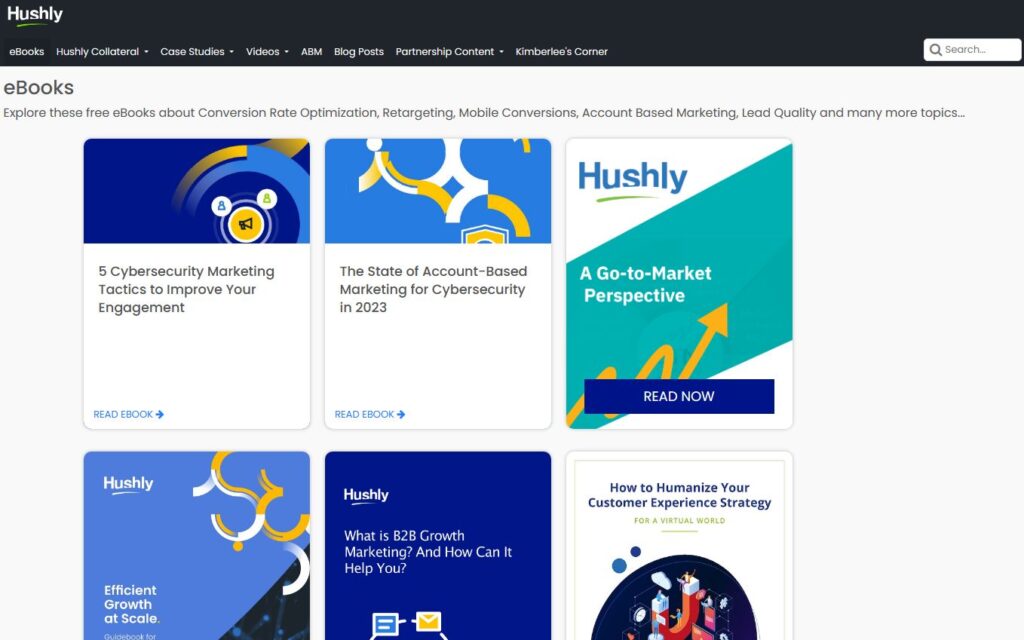Filters
Content Type
Topic
5 Benefits of Having a B2B Resources Page and How to Use It
B2B marketing is all about finding ways to provide your audience with valuable content and drive conversions. Driving traffic to your website and generating backlinks will boost your SEO and lead to even more traffic. One of the best ways to accomplish this is with a high-quality resources page.
Let’s explore the benefits of having a B2B resources page, how it can help your business, and tips on creating one that effectively serves your audience and drives results.

What Is a B2B Resources Page?
A B2B resources page is a dedicated section on a business website that offers a wide range of free or gated content to visitors. Its primary purpose is to provide value, answer frequently asked questions, solve problems, and nurture prospects at different stages of the buyer’s journey. For a resource page example, take a look at Hushly’s own resources page.

5 Benefits of a Resources Page
From thought leadership to adding value to technically complex products, your resource page is an incredible business tool. Here are ways you can benefit from it:
1. Establish Your Company as a Thought Leader
A well-structured resources page can help you build trust with your audience, demonstrate your expertise in your industry, and increase your brand’s visibility. Thought leadership is essential for businesses looking to differentiate themselves from competitors and foster long-lasting relationships with their target audience.
To establish thought leadership, include the following types of content on your resources page:
- Original research and data analysis, showcasing your company’s unique insights
- In-depth case studies that highlight your customers’ success stories
- Comprehensive industry reports and trend analysis, positioning your brand as a go-to source for the latest news and developments
- Educational resources and how-to guides that address your audience’s pain points and needs
By consistently producing and sharing high-quality content, you can cultivate a reputation as an industry expert and thought leader.
2. Boost Web Traffic
A well-optimized resources page can significantly improve your website’s SEO, attracting more visitors and enhancing user engagement. Consider the following strategies to accomplish this:
- Internal linking: Create links between your resources page and other relevant pages on your website, helping search engines find and index your content.
- Keyword optimization: Incorporate relevant keywords into your resources page, enabling it to rank higher in search results and attract more organic traffic.
- Meta descriptions: Craft clear and concise meta descriptions for your resources page to entice users to click through from search results.
- Social media promotion: Share your resources page on social media platforms, driving more traffic to your website and increasing brand visibility.
- Email marketing: Include links to your resources page in email newsletters, encouraging subscribers to visit your site and explore your content.
3. Guide the Buyer Journey
The B2B buyer’s journey typically consists of several stages, including awareness, consideration, and decision. A resources page can support the lead nurturing process by providing appropriate content to potential customers at each stage:
- Awareness stage: Prospects may be seeking educational content to help them understand a problem they’re facing or identify opportunities for growth.
- Consideration stage: Case studies, product comparisons, or industry benchmarks can help prospects evaluate their options and make informed decisions.
- Decision stage: Prospects may require more in-depth information, such as product demos, free trials, or personalized consultations, to finalize their choice.
Ensure your resources page offers a variety of content types tailored to each stage of the buyer’s journey. Include a mix of gated and ungated content and provide clear calls-to-action that encourage visitors to take the next step in their journey.
4. Create a Central Hub for High-Value Content
Consolidating valuable resources in one central location helps your brand build authority and makes it easier for visitors to find the information they need. To maximize the potential of your resources page as a hub for high-value content, consider the following tips:
- Include a variety of content types: Offer diverse content such as whitepapers, case studies, e-books, videos, infographics, podcasts, webinars, and industry reports to showcase your company’s expertise across various topics.
- Make it easy to browse: For example, you can organize the page in a blogroll format with filters by topic or content category, allowing visitors to find what they’re looking for quickly and efficiently.
- Include optimized meta information and tags: Utilize descriptive titles and tags for each resource to enhance searchability and make it easy for users to identify relevant content.
- Suggest related important content: Create callouts for particularly significant resources, highlighting them on the page and drawing visitors’ attention.
5. Increase Conversions
A resources page can help boost conversions by establishing trust and credibility with potential customers. By providing valuable content, you encourage visitors to take the next step in their buyer’s journey and convert.
To use your resources page effectively for increasing conversions, consider the following strategies:
- Include clear calls-to-action (CTAs): Strategically place CTAs throughout the page, guiding visitors toward a specific action, such as downloading a whitepaper, signing up for a webinar, or scheduling a consultation.
- Offer some gated content: Provide in-depth content, such as e-books or webinars, in exchange for contact information. This generates leads for your business and enables you to follow up with potential customers, moving them further along in the buyer’s journey.
- Design with conversions in mind: Ensure your resources page features CTAs that are clear, concise, and visually appealing. Use contrasting colors to make them stand out on the page, and place them prominently to capture visitors’ attention.
How to Create Your Own B2B Resources Page
When creating a B2B resources page, follow these steps to ensure its success:
1. Determine Your Goals
Identify your resources page’s goals, whether it’s lead generation, increased brand awareness, or establishing thought leadership. This can help you plan and structure your resources page accordingly.
2. Know Your Target Audience
Find out who your ideal customers are and what types of content they will find most valuable.
3. Choose Your Content
Select the content types you plan to feature on your resources page, including whitepapers, case studies, webinars, videos, infographics, podcasts, and industry reports.
4. Plan Your Structure
Consider how you want to organize your content. Options include a blogroll format with filtering options or a mega-navigation menu.
5. Create Your Content
Produce high-quality, well-written content that provides value to your target audience. Ensure each piece of content is relevant, informative, and engaging.
6. Add Calls-to-Action
Promote webinars, demos, free trials, and more to guide users through the buyer’s journey.
Hushly Can Help You Create High-Quality Resource Pages
A B2B resources page is an indispensable tool that offers numerous benefits, including thought leadership, increased web traffic, lead nurturing, content organization, and higher conversion rates. By following the tips and strategies in this guide, you’ll be well on your way to creating a successful resources page.
If you’re interested in tools that will help you create high-quality resource pages, reach out to Hushly and request a demo today.
The post 5 Benefits of Having a B2B Resources Page and How to Use It appeared first on Hushly.



